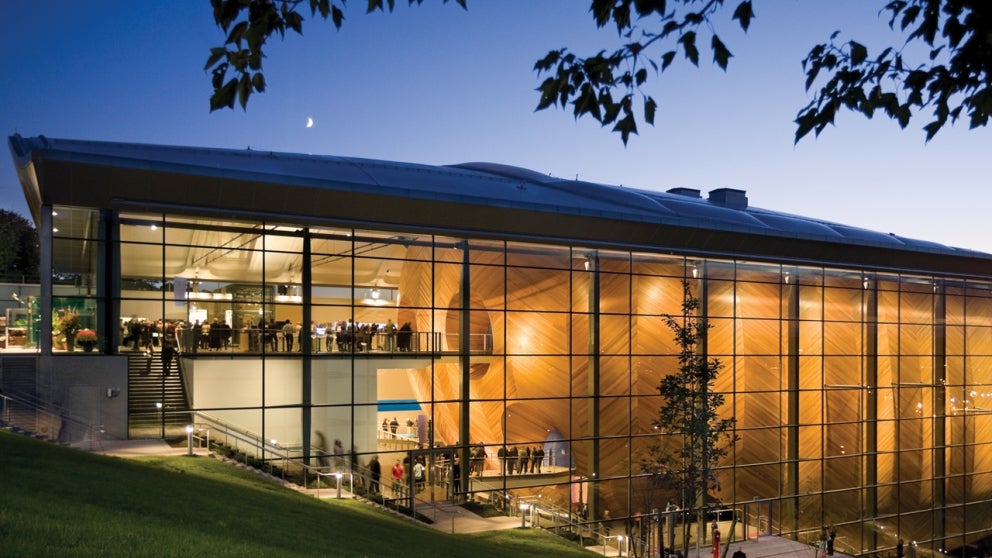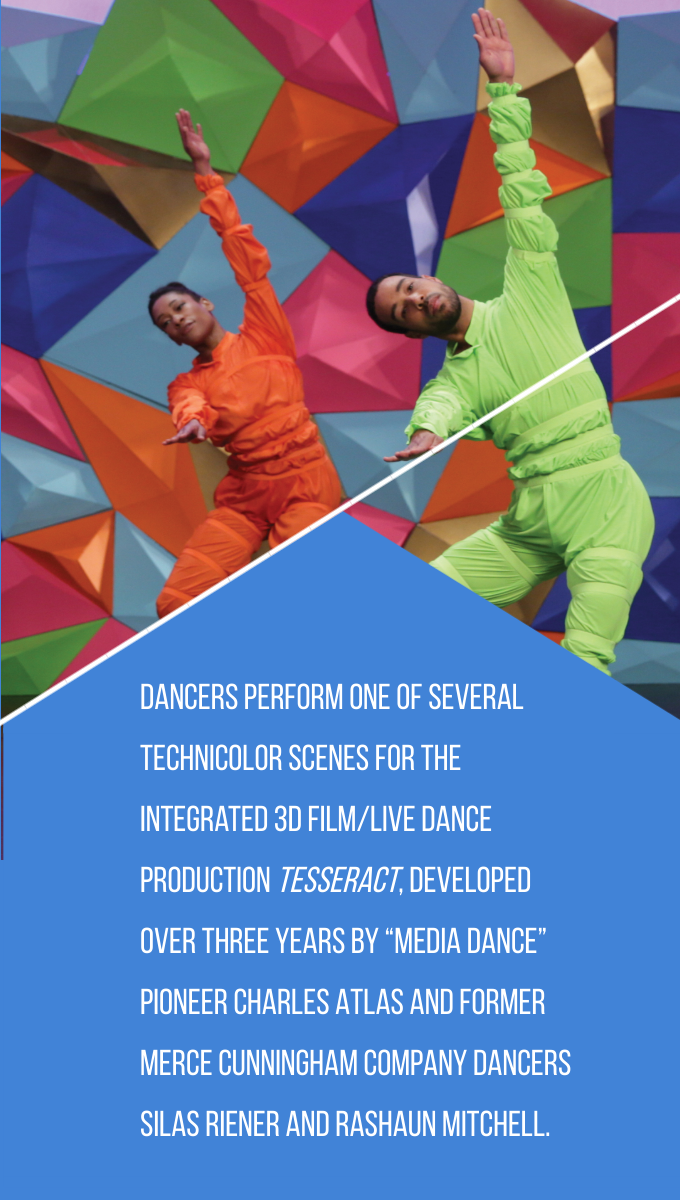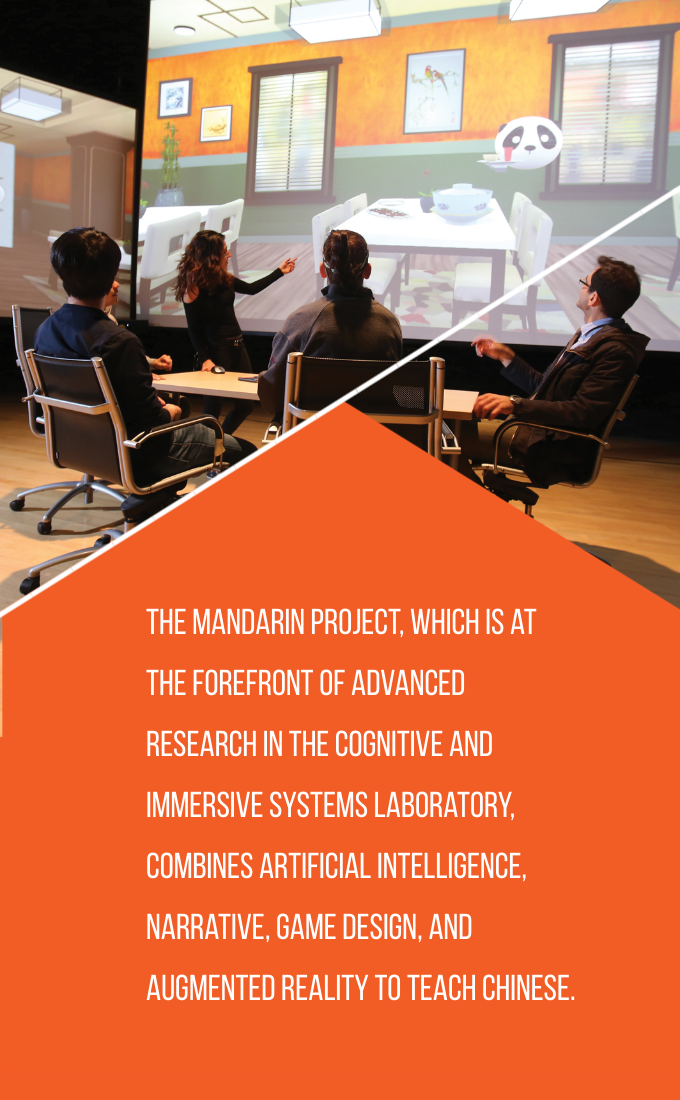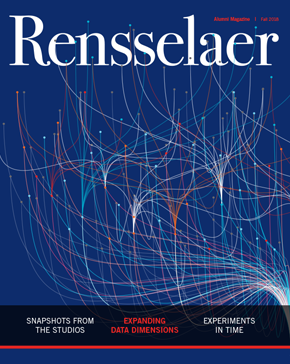

Experiments in Time
By Josh Potter
Since the ribbon cutting for the Curtis R. Priem Experimental Media and Performing Arts Center on Oct. 3, 2008, EMPAC has helped forge a new paradigm for cross-disciplinary research and production on campus while positioning Rensselaer as a major player in the international art world.
When the Formosa Quartet takes to the stage at the Curtis R. Priem Experimental Media and Performing Arts Center on October 11, it represents, by director Johannes Goebel’s count, the 5,557th day of the EMPAC program. By more conventional metrics, this performance marks the 10th anniversary of the landmark center’s opening and the start of a three-day event — dubbed 10YEARS — being held to celebrate the occasion.
With a twinkle in his eye, Goebel insists it’s the first figure that matters more to the programmatic vision of EMPAC, not the legacy of completing a decade. While anniversaries are often taken as an opportunity to look back on past achievements, Goebel says, “I’m interested in what happens now! And how to create ever-new ‘nows’ in the future.”

As the string quartet leads its audience throughout all four of EMPAC’s venues, performing classical repertoire selected to match the architectural acoustics of each space, it is indeed in the present tense of listening and feeling the sounds reverberate through the room and against one’s body that Goebel’s point is driven home. While the scientific method can set future-oriented goals for inquiry, and retrospectively consider a body of collected data, art instead provides a reflective space for the human senses to make integrative sense of experience in real time.
As Goebel puts it, “Science aims at understanding the underlying systems of nature and life. Engineering creates tools and methods for supporting human life. Art continually opens doors on the present moments of experience and our search for meaning, and that’s a necessity for being human.”
“Science aims at understanding the underlying systems of nature and life. Engineering creates tools and methods for supporting human life. Art continually opens doors on the present moments of experience and our search for meaning, and that’s a necessity for being human.”
— Johannes Goebel
So it’s fitting, in a poetic way, that the anniversary of EMPAC’s literal door opening be celebrated with a diverse slate of performances selected to figuratively do the same. The anniversary celebration showcases for Rensselaer students and audience members traveling from well beyond the region a host of world premieres, developed over the past year in residence at the center, including a multimedia performance by visual artist Wu Tsang, a 3D sound installation demonstrating EMPAC’s new Wave Field Synthesis audio system, a dance-film installation by Cypriot choreographer Maria Hassabi, a feature film by Canadian artist Isabelle Pauwels, and an immersive theater performance by “world-maker” Yara Travieso, capped off by a concert performed by the International Contemporary Ensemble using a 64-speaker Ambisonic “dome” built around the audience. The festival encompasses a talk by Goebel on the philosophy and politics of digital archiving, a demonstration by CISL director Hui Su on research currently underway at the Cognitive and Immersive Systems Laboratory (CISL @ EMPAC), and the unveiling of the second volume of EMPAC’s “White Book,” Programming EMPAC: Days 4,159—5,476, a comprehensive document of every project undertaken at the center since its inception. A new video kiosk in the EMPAC lobby now allows visitors to browse and view full-length documentation of over 400 productions and performances created at EMPAC.
More than an anniversary, the 10YEARS celebration distills what makes the EMPAC program as radical and transformative 10 years on as it was when President Shirley Ann Jackson first assembled the Electronic Media and Performing Arts Task Force in 2000, as one of her first major actions toward the realization of a new paradigm for cross-disciplinary education and research at the nation’s oldest polytechnic. While this vision has matured into The New Polytechnic, following EMPAC’s early transition from an “electronic” enterprise to the more integrative “experimental” project it now carries in its name, EMPAC continues to anchor the fleet of cross-disciplinary initiatives that have arisen in recent years, such as Art_X, while establishing Rensselaer in a much broader academic and cultural context.

In her remarks at the building’s opening in 2008, President Jackson challenged the Rensselaer community “to dare to invest in new enterprises — areas in which Rensselaer had not been known but which held great promise and value.”
This effort has not gone unnoticed. Upon opening, EMPAC was hailed by The New York Times as “a technological pleasure dome for the mind and senses . . . dedicated to the marriage of art and science as it has never been done before,” that is, something unprecedented in both higher education and across the traditionally distinct fields of scientific research, technological engineering, and artistic production. Over 5,500 days (and counting), the center has hosted artists, researchers, and scholars from nearly 30 countries to undertake collaborative projects, among them more than 100 commissioned projects that have gone on to tour the world, in addition to over 600 productions presented on stage and screen for the Rensselaer community.
EMPAC productions have garnered a host of awards, including a Pulitzer Prize nomination (Kate Soper’s opera Ipsa Dixit), an Academy Award Shortlist selection (Laurie Anderson’s film Heart of a Dog), and recognition from publications like Rolling Stone, Pitchfork, and The Wire for recordings produced at the center (by Tim Hecker, Ben Frost, Laurel Halo, and others). This spring, Artforum magazine celebrated EMPAC’s “NASA-grade” production facilities in a profile of EMPAC artist-in-residence Patricia L. Boyd.
“When I arrived at EMPAC, it was rare for artists and colleagues in the visual arts field to know what EMPAC was, especially in Europe,” reflects Victoria Brooks, who came from England to work as EMPAC’s curator of time-based visual art in 2013. “Now everyone knows about the building and the program because in the U.S. and internationally there isn’t any other institution doing what we’re doing.”
In recent years, EMPAC has hosted visitors from a wide range of international universities and cultural institutions — including both technological and liberal arts colleges, the San Francisco Symphony, the University of Tasmania, the University College of Opera in Stockholm, the new Perelman Center for the Performing Arts at the World Trade Center in New York City, and the West Kowloon Cultural District, a massive 100-acre art center currently under construction in Hong Kong — all interested in learning how Rensselaer was able to realize both EMPAC’s infrastructural and programmatic capabilities.
While it’s easy to see how the EMPAC program radically expands the framework for education, research, and cultural life on the Rensselaer campus, EMPAC is similarly changing the landscape for artistic research and production on an international level. Brooks — whose curatorial work focuses on the expansion of visual art from the static container of the white-box gallery into the more dynamic time-based realm of moving-image and performance — often initializes her EMPAC productions in collaboration with other institutions, like the Museum of Modern Art (MoMA) in New York City, or the Walker Art Center in Minneapolis. In much the same way that scientific researchers often collaborate between academic institutions, or with private sector entities (as with CISL’s joint venture with IBM Research), these artistic co-commissions pool resources, expertise, and infrastructure to undertake projects that wouldn’t be possible otherwise.

“We can do things here that museums like MoMA can’t,” Brooks says, recognizing not only the exceptional infrastructure in the EMPAC building, but the expertise of the staff, programmatic opportunities within the residential production framework, and an expanded concept of research bridging both artistic and scientific modalities.
Goebel echoes the sentiment, claiming, “The EMPAC curatorial program is a paradigm that does not exist to my knowledge anywhere else on the planet.” Under Goebel’s administration, a staff of curators — Ashley Ferro-Murray (associate curator of theater and dance), Argeo Ascani (curator of music), and Victoria Brooks (curator of time-based visual art) — pursue distinct-yet-complementary programmatic trajectories, commissioning new projects from a cadre of international artists working at the leading edge of their form, and then developing these projects through extensive residential engagements at EMPAC.
As a result, EMPAC production residencies have become coveted opportunities for artists seeking to expand their work into new aesthetic dimensions and experiential spaces. This spring, The New York Times followed the two-week production residency undertaken by electronic musician Daniel Lopatin (AKA Oneohtrix Point Never) in advance of a sold-out three-night premiere of his multimedia “concertscape” MYRIAD at Manhattan’s cavernous Park Avenue Armory. Lopatin and his collaborators used the opportunity to rehearse music, prepare a complex projection apparatus, and build an enormous inflatable sculpture that would be deployed mid-show. Of EMPAC’s role in the production, Lopatin said simply, “We couldn’t have done it without you.”
Beyond curatorial and technical support, EMPAC production residencies pursue a form of collaborative experimentation and research meant to engender new social systems and ways of working, something Brooks likes to refer to as new “protocols.”
 As a point of contrast, she points to the way that Hollywood movies are produced. Because of the commercial objectives driving the production, there are certain workflows and hierarchies established to ensure efficiency of execution. As a result, there’s a set of rules that everyone in the industry follows and a certain language that everyone understands, but that comes with a calcification of innovation on the level of form and content.
As a point of contrast, she points to the way that Hollywood movies are produced. Because of the commercial objectives driving the production, there are certain workflows and hierarchies established to ensure efficiency of execution. As a result, there’s a set of rules that everyone in the industry follows and a certain language that everyone understands, but that comes with a calcification of innovation on the level of form and content.
“The interesting thing is when we diverge from these industrial practices and protocols,” Brooks says. Pursued in a truly collective, cross-disciplinary spirit, with artists working in constant collaboration with highly skilled engineers and technical staff, EMPAC productions not only generate new artworks and new technologies, but also new social structures and protocols.
A good example is Brooks’ recent project with French artist Laure Prouvost. Prouvost is a well-recognized figure in the visual art world, having won the Turner Prize (the UK’s most prestigious art award) in 2013, and is representing France at the upcoming Venice Biennale in 2019. Working with curators at the Walker, Brooks started with the simple question: “What would Laure do if we gave her access to theatrical infrastructure and technology for the first time?” Over the course of two years and a series of residencies undertaken at EMPAC and the Walker, the question was slowly pursued, eventually resulting in They Are Waiting for You, which premiered last fall at EMPAC before traveling to the Walker to be performed in conjunction with Prouvost’s new gallery installation.
Working alongside choreographers, musicians, and stage technicians toward the realization of her first performance for the proscenium stage, Prouvost was forced to expand her disciplinary language (based in visual art and video) and learn to speak a new meta-language that would encompass the languages of each collaborator. Through this method of artistic research, the emergent social protocol — a completely new way of working together — was just as novel as the finished performance.

The same venues and tools that make EMPAC a leading-edge performance space also make it an exceptional laboratory for research at the interface between digital technology and human experience. Recent areas of inquiry include advanced visualization, acoustics, sensor design, lighting design, haptics, social interaction, and immersive environments, among others.
The Wave Field Synthesis Audio Array is a recent project. Developed by EMPAC audio engineers, this 500-speaker array is one of the most extensive and precise spatial audio systems in the world. By placing a virtual sound source in physical space, the system creates “holophonic” sound that moves around the listening space, not unlike the sonic equivalent of 3D cinema.EMPAC is also home to the Cognitive and Immersive Systems Laboratory (CISL), a joint research venture between Rensselaer and IBM. With projected applications in the fields of medicine, business, cybersecurity, and education, CISL is developing prototypes for the next generation of human-computer interfaces that will help solve complex global challenges.
With EMPAC’s spacious studios — optimized for human perception and interaction — along with its complex media and networking infrastructure, researchers across the five schools at Rensselaer have a powerful tool in the quest to better understand human sensory experience, communication, and interaction with computing systems.
 According to Goebel, EMPAC productions model a core notion of The New Polytechnic that is being enacted across the Institute. By exploring the spaces where traditional disciplinary boundaries overlap — perhaps between civil engineering and architecture, or cognitive science and game design — we expand our frame of intelligibility, collapse artificial boundaries, and create the possibility for new ideas to arise.
According to Goebel, EMPAC productions model a core notion of The New Polytechnic that is being enacted across the Institute. By exploring the spaces where traditional disciplinary boundaries overlap — perhaps between civil engineering and architecture, or cognitive science and game design — we expand our frame of intelligibility, collapse artificial boundaries, and create the possibility for new ideas to arise.
Art delivers this idea in a direct, sensory way, but it’s also the objective of more scientific research initiatives taking place at EMPAC, most prominently with CISL. Working in EMPAC Studio 2 on the design and construction of a cognitive and immersive “situations room,” which enables groups of human users to interact with large datasets through responsive computing agents, CISL is similarly pursuing the research and development of novel protocols for the overlapping domain of social space and computing interface. What links this work to the kind of research and experimentation happening with an artwork like Prouvost’s is a content-driven approach to the project, using technology to conceive ideas and experiences, not the other way around.
Viewed this way, the EMPAC building itself was the first human-scale research project undertaken by the center. As Goebel recalls, a major goal was to “build a space that works well for humans first, then add the technology.” For instance, by designing the acoustics of the space to accommodate the human voice and acoustic music, electronic infrastructure could be added to open further possibilities. Not vice versa. The purpose for this orientation is that technology changes fast, but the human senses and corresponding social environment do not. Every piece of the design process — and by extension every media platform that EMPAC has developed (from the Campfire immersive computing interface to Wave Field Synthesis) — had to follow this functionality, considering first the qualitative experience of human perception.
This continues to be a radical proposition, as virtual and augmented reality technologies have enjoyed resurgent interest in recent years and more VR platforms work their way to the marketplace. Prevailing wisdom might question the return on investment of a 220,000-square-foot building while cyberspace seems to be where the action is.
Goebel is unconvinced. “There will always be a difference between the individualized approach to something and one that considers the social experience of interacting with groups,” he says. “EMPAC went against the grain of how the triad — art, science, and technology — has been posited in the past decades, which has been mainly technology-driven, and we continue to do so.”
It can be tempting to celebrate the development of new technologies for the sheer technical brilliance that hatches them, but a core idea of The New Polytechnic is that this is only a piece of what it takes to educate students who are, in President Jackson’s words, “also articulate, broadminded, and humane.” Echoing the idea at this spring’s Commencement Colloquy, genomic science pioneer Dr. Eric Lander said, “We cannot just discover and invent; we must ensure that our discoveries and inventions are used to serve humanity.”
In short, we can’t simply “tech” our way out of all our global challenges; we must create humane relationships to our technologies and use our technologies to create humane relationships to one another. And to do this requires a method of social and self-reflection, something that the arts offer at their core.
For jazz great Herbie Hancock, who visited EMPAC this spring for the Commencement Colloquy, there’s a step that has to happen before we go out and change the world, a process of self-reflection that can happen every time we perform or experience a challenging work of art.
“If we take it upon ourselves to transform ourselves,” he said, “we transform others and the world around us.”















